The COVID-19 Emergency has created new demands on communications and has made clear the need to provide services remotely to the extent possible. Providers need to communicate more, between themselves and with their patients, and the time to implementation of new services to meet these needs is almost zero, leaving no room for the usual processes of approval and adoption that health care is used to. In order to facilitate the delivery of services and necessary communications during the emergency, the US Department of Health and Human Services has issued guidance relaxing some HIPAA requirements pertaining to teleconferencing tools and reiterating HIPAA allowances for communication with family and friends of patients.
The COVID-19 Emergency has placed unprecedented demands on healthcare providers to provide services but places severe limits on the ability to safely see patients in person, and business-grade teleconferencing technologies have stepped in to fill the gap in Telemedicine services. HHS has recognized that such services, even while not necessarily meeting the letter of HIPAA regulations, can be used in a secure and reasonable way during the emergency, and has provided guidance to that effect. Commonly-used applications like FaceTime, Skype, and Zoom, that are not public-facing in their operation, may be used, but public-facing apps such as FaceTime Live or a chat room in Slack are not appropriate. This session will explain the difference between public- and non-public-facing services, what should be done in using the permitted services, and what must be done once the emergency is over and the relaxation of enforcement ends.
In addition to the need for remote communications, first responders may need to take steps to protect themselves and the public from infected patients, which could indicate the condition of the patient to others, in violation of privacy regulations. HHS has issued guidance that permits the necessary communications to take place in the interest of public safety and otherwise allows communications necessary when needed to provide treatment, when required by law, when first responders may be at risk for an infection, and when disclosure is necessary to prevent or lessen a serious and imminent threat, to protect the health and safety of first responders and the public.
HHS Guidance also reminds us of reasonable allowances for communicating with the family and friends of a patient when it is in the patient’s best interest to do so. It is not always possible to obtain formal permission to contact family and friends of a patient and the rules do permit appropriate communication, relating to any issues at hand, when professional judgment dictates. In addition, sharing information with disaster relief organizations, such as the Red Cross, is permitted as necessary to provide care and respond to the emergency.
Join us on our live webinar to know Security Requirements that have Enforcement Discretion During the Pandemic.
